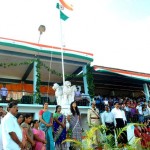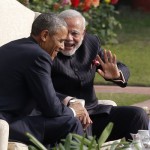NEW DELHI: President Barack Obama and his Indian counterpart broke through a five-year impasse Sunday to pave the way for American companies to build nuclear power plants here as the two countries sought to transform a fraught geopolitical relationship into a fresh partnership for a new era of cooperation.
Opening a three-day visit amid pomp and pageantry, Obama moved to clear away old disputes that have stalled progress toward an alignment between the world’s largest democracies, a goal that has eluded the past three U.S. presidents. Few obstacles to that have been more nettlesome in recent years than the deadlock over nuclear power.
“Today we achieved a breakthrough understanding on two issues that were holding up our ability to advance our civil nuclear cooperation, and we’re committed to moving towards full implementation,” Obama said at an appearance with Prime Minister Narendra Modi at Hyderabad House, the princely palace used by the government. “And this is an important step that shows how we can work together to elevate our relationship.”
The details remained vague, and it was unclear whether the understanding would convince American companies, such as General Electric Co. and Westinghouse, to invest in India’s civilian nuclear development. The companies had pressed India to rewrite its liability law, which Sunday’s understanding did not call for, and so they will have to judge whether it is enough to resolve their legal concerns. But the fact that both governments were willing to dispense with a dispute that has frustrated them since 2010 underscored the mutual desire to reinvent the relationship.
Obama and Modi also renewed a 10-year defense pact, agreed to joint military hardware production and resolved to reduce the threat of greenhouse gas emissions to the world’s climate. The climate agreement included mostly minor initiatives, none of the scale of the deal that Obama struck in November with China. But U.S. officials were encouraged that after years of India’s disavowing responsibility to help curb emissions, Modi told Obama that climate change was “an article of faith” for him and expressed determination to fight it.
The amity between the two leaders was palpable from the start as Modi broke with protocol to greet Obama at the airport with a warm handshake and a hug. During their later public appearance, Modi referred to the president as “Barack” and thanked him for his “deep personal commitment” to their friendship. In a toast at a state dinner Sunday evening, Obama returned the favor, calling Modi “my partner and friend.”
“This new partnership will not happen overnight,” Obama said at the earlier appearance. “It’s going to take time to build and some patience. But it’s clear from this visit that we have a new and perhaps unprecedented opportunity, and deepening our ties with India is going to remain a top foreign policy priority for my administration.”
Obama’s visit, his second as president, is a major event in India. Despite lingering distrust over Washington’s history of support for rival Pakistan, the United States enjoys widespread popularity here. For weeks, the Hindi news media has dissected details of Obama’s visit, running half-page graphics of his limousine and airplane, broadcasting a detailed report about his BlackBerry and advising Michelle Obama on couture saris to wear.
The president’s visit was marred by his decision to cut it short by several hours and skip a tour of the Taj Mahal on Tuesday to fly to Saudi Arabia to pay respects to the family of King Abdullah, who died Friday. But that was quickly set aside as Obama was welcomed with a red carpet, an honor-guard and a 21-gun-salute. He threw flowers on the memorial to Mahatma Gandhi at Rajghat. He and Modi took a walk through a garden and shared tea. And Obama was announced by trumpets at the state dinner.
Modi’s reference to Obama by his first name drew notice.
“It’s never been done before in India, to my knowledge,” said Baijayant Panda, an Indian lawmaker. “This is clearly sending signals to a lot of people, a lot of heads of government that matter.”
Still, the spectacle outweighed the substance in most cases.
On climate change, India agreed to move to phase down hydrofluorocarbons, or HFCs, according to a treaty known as the Montreal Protocol. But more broadly, India set no specific goals limiting greenhouse gases, as Beijing did in November. India is the third largest carbon polluter behind the United States and China but has resisted bolder measures, citing its need to lift hundreds of millions out of poverty.
Instead, the two sides agreed to promote solar, wind and other clean energies, and Modi said he would support a global climate pact to be shaped in Paris this year. Modi said he felt no pressure to match China’s commitment.
“Climate change itself is a huge pressure,” he said. “Global warming is a huge pressure.”
The nuclear understanding may finally bring to fruition an agreement that former President George W. Bush reached with India in 2006 to end a moratorium on sales of nuclear fuel and reactor components to India, stemming from its first nuclear test in 1974. The promise of a thriving new nuclear trade never materialized because of a 2010 Indian law that would hold American companies liable for accidents in a way that they said went beyond an international convention, a delicate issue in a country still scarred by the Bhopal chemical disaster 30 years ago.
Obama aides said Indian officials provided reassurances that their liability law conformed to the international convention and that it should provide what one U.S. official called “extra security” for foreign companies. Moreover, India indicated it would set up a government-backed insurance pool to cover some of the risk, but not all of it.
US officials said they also worked out an understanding of how to track American-provided nuclear materials, as required by law. Critics said it appeared Obama had given in on the tracking requirement. Officials denied that, but details of both agreements were scarce, and they still needed to be translated before being signed.
Westinghouse and GE Hitachi Nuclear Energy, a partnership with a Japanese industrial corporation, welcomed the agreement without declaring whether it offered enough protection.
In a statement, GE said the test would be whether it “brings India into compliance with the International Convention of Supplementary Compensation,” a global liability accord. Westinghouse praised the progress toward resolving issues “that will enable Westinghouse and other U.S. companies to participate in India’s growing nuclear energy market.”
Daniel Roderick, the chief executive of Westinghouse, is in New Delhi to attend a business leaders’ meeting with Obama on Monday, but it was not known whether he was consulted.
Some analysts said the understanding sounded vague and inconclusive.
“It’s a deal on principles rather than specifics, which as far as I’m concerned is not a deal at all,” said Abhijit Iyer-Mitra, a security analyst at the Observer Research Foundation in New Delhi. “A lot of it’s just, you know, blowing the trumpet.”
Sujatha Singh, India’s foreign secretary, insisted that was not true.
“Let me underline: We have reached an understanding,” she said. “The deal is done.”
C. Raja Mohan, another analyst at the Observer Research Foundation, said it showed Modi’s determination to resolve issues with the United States: “The traditional reluctance to be seen with the Americans is over.”



